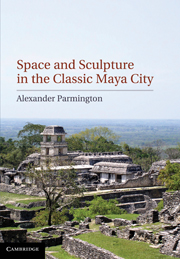Book contents
- Frontmatter
- Contents
- List of illustrations
- List of tables
- Summary
- Acknowledgements
- Introduction
- 1 Defining the Maya built environment
- 2 Investigative considerations and methodology
- 3 Access analysis of the Palenque Cross Group and its sculpture
- 4 Architectural and sculptural programs of the Palenque Palace Group
- 5 Access analysis of the architectural and sculptural programs of the Palenque Palace Group
- 6 Access analysis of Maya art and architecture: Summary and conclusions
- Appendixes 1–7
- Bibliography
- Index
Introduction
Published online by Cambridge University Press: 05 August 2011
- Frontmatter
- Contents
- List of illustrations
- List of tables
- Summary
- Acknowledgements
- Introduction
- 1 Defining the Maya built environment
- 2 Investigative considerations and methodology
- 3 Access analysis of the Palenque Cross Group and its sculpture
- 4 Architectural and sculptural programs of the Palenque Palace Group
- 5 Access analysis of the architectural and sculptural programs of the Palenque Palace Group
- 6 Access analysis of Maya art and architecture: Summary and conclusions
- Appendixes 1–7
- Bibliography
- Index
Summary
The objectives of this book are to describe the methods and present the results of an investigation into the utilisation of sculpture by the Classic Maya as “signposting,” as a means of signaling the function and the hierarchical division of ritual and administrative “spaces” in a city centre. Due to limitations in the breadth of literacy among the greater Maya (a.d. 250–900) population, imagery (as displayed on monuments and architecture) was used by the Maya elite as a supplementary communicative tool. Monumental art was used to signal, among other things, the “identities of sacred places and [their] function through sculptural composition … to people using them or coming into the spaces they addressed” (Schele and Mathews 1998: 27). Most often, attempts to understand the function and exclusivity of space within Classic Maya city centres have focused on the interpretation of architectural variation (i.e., points of restricted access implying public and private domains; see Harrison 1970; Andrews 1975; Pendergast 1992). Additional methods of inquiry have included epigraphic decipherment, ethnohistoric investigation, ethnographic analogy, and analysis of artefact residues and their distribution (e.g., Fash 1983; Schele and Mathews 1998; McAnany and Plank 2001).
- Type
- Chapter
- Information
- Space and Sculpture in the Classic Maya City , pp. 1 - 3Publisher: Cambridge University PressPrint publication year: 2011



